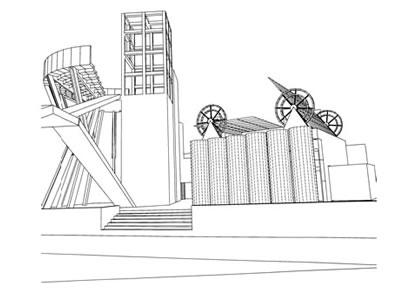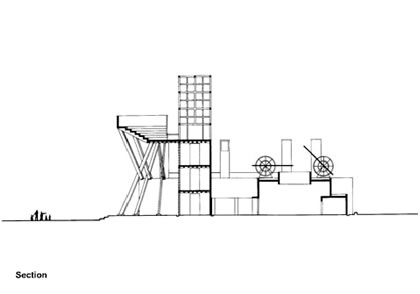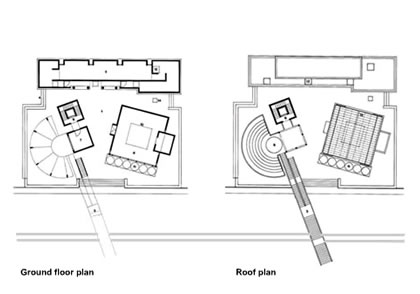 |
Greek Pavilion
Venice Biennale, 1991
The art pavilions for the Venice Biennale
express a festive presence-a panegyric iconography They are
intended to be both joyful and purposeful. After all, Venice
is a city of both fantasy and reality. Adopting forms that evoke
the memory of Greco-Venetian culture, they attempt to fuse Hellenic
and Venetian imagery.
The architects have recognised the circulation
path of the Biennale campus by providing an additional bridge over the
adjacent canal, and activated the site by developing a concept that
has spatial and physical relationship with the new bridge as well as
with the greater Venetian context. A belvedere/ theatre, rising above
the trees and facing the Lido (on axis with Athens), provides an additional
symbol of the Biennale.
It was proposed that the Biennale should
remove its fences and open its campus to the surrounding park, so that
its buildings might be used by Venetians and visitors throughout the
year. A constant link would be formed between the city and this place.
Three buildings were designed that are independent
but interrelated spatially and architecturally. Together, they comprise
a micro-urban scheme that is both internalised and externalized, providing
diverse galleries as well as outside spaces for the display of sculpture.
Building A is a long, labyrinthine gallery for paintings and drawings.
Five periscopes (12m high) are located along the path of the gallery
to provide a variety of unusual points of view, juxtaposing real and
unreel images of the Biennale complex and beyond. Building B has a
square gallery for sculpture and the display of architectural objects.
Natural
light filters into the space through a large opening to the sky and
six water cylinders/fountains located along the western edge of the
gallery facing the canal. Two electronically operated solar roof panels
control the climate. Building C is a Greco-Venetian tower and belvedere/theatre
in the sky. It contains three smaller galleries for paintings and drawings,
accessible through an adjacent circulation tower. The top of the building
is crowned by an open-air theatre propped up by wooden supports All
three towers are in concrete, faced with reconstructed Istria stone.
Collaborators : Mark Gangi, Julian Reid, Kostas Kostopoulos, Sortris Papadopoulos
Model : Mark Gangi, Julian Reid
Photos : Tony Nagelmann, Mark Gangi
Below
: View, Section, Ground floor plan, Roof plan
|
 |


